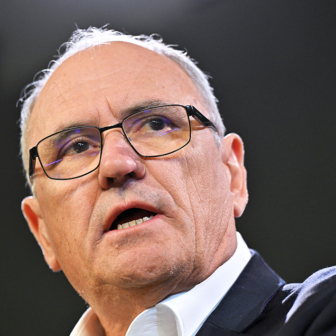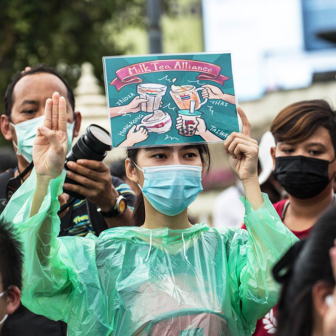A non-Labor government in Canberra might ordinarily expect solid support from business, if only because the alternative is much less palatable. But it’s not quite as simple as that. History tells us that the Liberals’ relationship with the big end of town can be far from cosy.
While the business community reacted warmly to the Morrison government’s return in the May election, relations between the corporate sector and the government have been rocky since then, and all indications point to even more turbulent times ahead. This isn’t surprising: the foreshadowed legislation to allow forced divestment of energy-company assets is without precedent in the history of corporate regulation in Australia and is sending shockwaves through not just the energy sector but the corporate sector as a whole.
Business must wonder who its friends are in Canberra. There was both dismay and astonishment at resources minister Matt Canavan’s attacks on the banks for their reluctance to finance Adani’s controversial coal development in Queensland, and many corporate leaders were taken aback by conservative Peter Dutton’s blunt “butt out” comments after widespread corporate support for same-sex marriage. Ministerial attacks on business leaders who take progressive positions on social issues sit most uneasily with the party’s traditional defence of free expression.
In the pre–Liberal Party days before the second world war, big business effectively had its own party — the Liberals’ non-Labor predecessor, the United Australia Party. The UAP had been hastily cobbled together in the wake of the defeat of the Nationalist government of Stanley Melbourne Bruce in 1929 and the defection of several Labor figures from the government of James Scullin in 1932.
While the parliamentary UAP was led by prime minister Joseph Lyons, one of the Labor defectors, the party itself was more or less controlled by a cabal of mostly Melbourne-based business leaders. They raised the funding, selected the candidates and dictated policy. Partly as a result, the UAP was derided by its critics as being anything but united, more concerned with protecting British than Australian interests, and less a party than a front organisation financed and directed by business interests. All these points contained at least a modicum of truth.
The party’s shortcomings were clearly recognised by one of its subsequent leaders, Robert Menzies, who became prime minister in 1939 after Lyons’s death. Forced out of office by his colleagues in 1941, Menzies would draw on his experiences in the UAP when he helped found a new non-Labor party, the Liberal Party. Menzies proclaimed that the new party was beholden to no vested interests — a tactical swipe both at the Labor Party, with its trade union links, and at the old, discredited UAP, seen by many Australians as having failed to deal with the misery of the Great Depression while looking after its own interests.
Menzies insisted that the Liberal Party would raise its own funds to secure its operational and political independence — a move that was most fiercely resisted in Sydney. With the Great Depression still fresh in his mind, he was acutely aware that big business, left to its own devices, would act in ways not always compatible with a democratic society. In his memoir Afternoon Light, Menzies explicitly rejected the notion that private enterprise should have an “open go,” arguing that the state quite properly had a role in enacting social legislation and providing for economic security. In fact, Menzies the lawyer and Menzies the politician often looked askance at business, seeing it as just another interest group, albeit an important one.
Even in the very early days of the Liberal Party, tensions were evident between Menzies and big business. Menzies clashed with the first national president of the party, T.M. (later Sir Malcolm) Ritchie, over plans to raise funds from the business sector, with Menzies labelling Ritchie and his close associates as “not politics conscious.” Ritchie hit back, declaring that he, not Menzies and not the parliamentary party, was more in touch with public opinion.
When Menzies achieved a sweeping victory in 1949, largely over the damaging fallout from Labor’s thwarted scheme to nationalise the private banks, the business community relaxed a little, comfortable for the time being that the socialist tiger had been contained. But that was merely a lull, not a truce.
Powerful elements within the party resented Menzies’s commitment to significant government regulation of the economy. A group of largely NSW members constituted what was known as a free-trade “cave” within the parliamentary party, pressing for an end to the two-airlines policy, for instance, and a withdrawal from commercial shipping operations. Backed by Sydney business interests, this group ensured that Menzies would never entirely have his own way on policy issues affecting the corporate sector.
Menzies came within a seat of losing government in 1961, after the disastrous “credit squeeze” budget brought in to address inflation. Business was highly critical of the budget, and some business leaders even wondered aloud if Labor might be a better option. The party’s federal president, Sir William Anderson, accused the government of “insolence of office,” claiming that if it had heeded advice from the organisation it wouldn’t have lost the support of key sections of the business community. He summarised the government’s attitude to the party as “we know best, little people.”
Not long after, the first attempts to legislate on trade practices elicited staunch resistance from sections of the business community, prompting the second serious confrontation between the party organisation and Menzies. Acting on behalf of the business community, the party flexed its muscles decisively when the government unveiled its promised legislation, condemning it as too harsh and far beyond what was necessary. Much debate and protracted negotiation took place, and the version enacted in 1967 — by which time Menzies had retired — was much attenuated.
Memories of the business tail wagging the political dog remained part of Liberal Party culture. In 1970 a young Liberal backbencher, Neil Brown, visited London and called on the high commissioner, Sir Alexander Downer, a former senior Menzies minister and Adelaide conservative grandee. Downer was hungry for political news from home and asked Brown how the embattled prime minister, John Gorton, was faring. On being told that Gorton was in political trouble, he said to Brown, “You must promise me one thing, Mr Brown. Never let the prime ministership fall into vulgar, commercial Sydney hands.”
Gorton was toppled in a party-room coup in 1971 and succeeded by William McMahon, member for the inner-Sydney seat of Lowe, a man widely distrusted in Victoria for what one Liberal described as his “reckless closeness” to Sydney’s business interests. McMahon’s successor after the party’s electoral defeat in 1972, Bill Snedden, another Victorian, was later to remark privately that the Liberals would never again entrust the leadership to a Sydneysider.
After Malcolm Fraser and Andrew Peacock, of course, it did just that. And, with the brief exception of Alexander Downer’s leadership, it has remained in Sydney hands ever since.
It was under John Howard (1996–2007) that business found its true champion. He consistently catered to its needs with policies including the introduction of the GST and changes to workplace laws. On his watch the strident voices of the business lobby, such as the Business Council of Australia, the Australian Chamber of Commerce and Industry and the Institute of Public Affairs, appeared to have merged with the Liberal Party.
Fast forward to the election of Tony Abbott in 2013 and business found chaos where it expected certainty. Few corporate tears were shed when Abbott was toppled by Malcolm Turnbull in 2015. A targeted Morgan Poll taken soon after the switch of leaders showed business owners, professionals and managers swinging decisively behind the new leader — with the two-party-preferred Coalition vote recorded at 61.5 per cent (up 12.5 per cent from pre-Turnbull) and the Labor vote at 38.5 per cent. More importantly, confidence among this group of business owners, professionals and managers had increased to 118.6 points (up 5.2 from pre-Turnbull). The pollster also found real business confidence soaring from 102.6 in August to 119.3 in October.
But Turnbull failed to meet business expectations, and dissension within his government failed to deliver what business wanted most — certainty, especially on the crucial energy front.
Scott Morrison, fresh from an election win, has the opportunity to restore relations with business. But the current confrontation suggests this might not happen anytime soon. •




